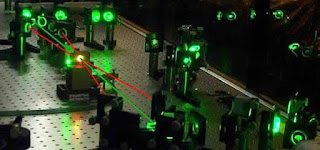Laser Technology and Quantum Teleportation

How is laser technology used to demonstrate teleportation at the micro level? Laser technology plays a crucial role in quantum teleportation. Scientists use lasers to entangle particles to teleport a quantum state from one object to another. Entanglement is a phenomenon where two particles become connected so that one particle's state depends on the other particle's state. Scientists use lasers to split photons into two separate entangled photons to create entangled particles. These entangled photons then carry quantum information between two distant points. By manipulating the polarization of these photons, scientists can control the direction in which they spin and, therefore, control the information they carry. Once entangled particles are created, they can be used for teleportation. In quantum teleportation, the quantum state of one object is transferred to another object without any physical connection between them. This process involves using entangled particles to trans...






